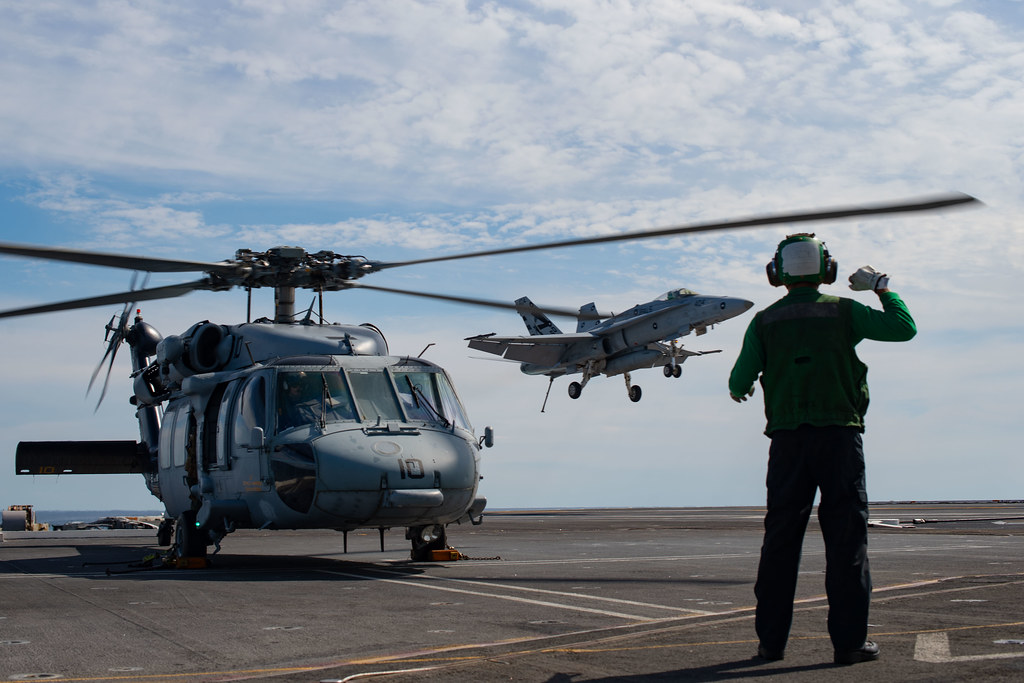
Описание: ATLANTIC OCEAN (Aug. 10, 2019) A Sikorsky MH-60S "Sea Hawk" helicopter assigned to Helicopter Sea Combat Squadron (HSC) 26 undergoes preflight checks as an F/A-18C "Hornet" assigned Air Test and Evaluation Squadron (VX) 23 lands on the flight deck of the aircraft carrier USS John C. Stennis (CVN 74) in the Atlantic Ocean, Aug. 10, 2019. The John C. Stennis is underway conducting routine operations in support of Commander, Naval Air Force Atlantic. MH-60S The Navy decided to replace its venerable CH-46 "Sea Knight" helicopters in 1997. After sea demonstrations by a converted UH-60, the Navy awarded a production contract to Sikorsky for the CH-60S in 1998. The variant first flew on 27 January 2000 and it began flight testing later that year. The CH-60S was redesignated MH-60S in February 2001 to reflect its planned multi-mission use. The MH-60S is based on the UH-60L and has many naval SH-60 features. Unlike all other Navy H-60s, the MH-60S is not based on the original S-70B/SH-60B platform with its forward-mounted twin tail-gear and single starboard sliding cabin door. Instead, the S-model is a hybrid, featuring the main fuselage of the S-70A/UH-60, with large sliding doors on both sides of the cabin and a single aft-mounted tail wheel; and the engines, drivetrain and rotors of the S-70B/SH-60. It also includes the integrated glass cockpit developed by Lockheed Martin for the MH-60R and shares some of the same avionics/weapons systems. It is deployed aboard aircraft carriers, amphibious assault ships, Maritime Sealift Command ships, and fast combat support ships. Its missions include vertical replenishment, medical evacuation, combat search and rescue, anti-surface warfare, maritime interdiction, close air support, intelligence, surveillance and reconnaissance, and special warfare support. The MH-60S is to deploy with the AQS-20A Mine Detection System and an Airborne Laser Mine Detection System (ALMDS) for identifying submerged objects in coastal waters. It is the first US Navy helicopter to field a glass cockpit, relaying flight information via four digital monitors. The primary means of defense has been with door-mounted machine guns such as the M60D, M240D, or GAU-17/A. A "batwing" Armed Helo Kit based on the Army's UH-60L was developed to accommodate Hellfire missiles, Hydra 70 2.75 inch rockets, or larger guns. The MH-60S can be equipped with a nose-mounted forward looking infrared (FLIR) turret to be used in conjunction with Hellfire missiles; it also carries the ALQ-144 Infrared Jammer. The MH-60S is unofficially known as the "Knighthawk", referring to the preceding "Sea Knight", though "Seahawk" is its official DoD name. A standard crew for the MH-60S is one pilot, one copilot and two tactical aircrewmen depending on mission. With the retirement of the "Sea Knight", the squadron designation of Helicopter Combat Support Squadron (HC) was also retired from the Navy. Operating MH-60S squadrons were re-designated Helicopter Sea Combat Squadron (HSC). The MH-60S was to be used for mine clearing from littoral combat ships, but testing found it lacks the power to safely tow the detection equipment. On 6 August 2014, the U.S. Navy forward deployed the Airborne Laser Mine Detection System (ALMDS) to the U.S. 5th Fleet. The ALMDS is a sensor system designed to detect, classify, and localize floating and near-surface moored mines in littoral zones, straits, and choke points. The system is operated from an MH-60S, which gives it a countermine role traditionally handled by the MH-53E "Sea Dragon", allowing smaller ships the MH-53E can't operate from to be used in the role. The ALMDS beams a laser into the water to pick up reflections from things it bounces off of, then uses that data to produce a video image for technicians on the ground to determine if the object is a mine. The MH-60S will utilize the BAE Systems Archerfish remotely operated vehicle (ROV) to seek out and destroy naval mines from the air. Selected as a concept in 2003 by the Navy as part of the Airborne Mine Neutralization System (AMNS) program and developed since 2007, the Archerfish is dropped into the water from its launch cradle, where its human operator remotely guides it down towards the mine using a fiber optics communications cable that leads back up to the helicopter. Using sonar and low-light video, it locates the mine, and is then instructed to shoot a shaped charge explosive to detonate it. BAE was awarded a contract to build and deliver the ROVs in April 2016, which will be delivered in September 2017.
Tags:
Поиск и фотоизображения предоставлены компанией Flickr с помощью сервиса Flickr API согласно Правилам пользования сайтом Flick.com и его сервисами. Графические изображения являются публичными, размещёнными их авторами в свободный доступ (Public) и физически расположены на серверах Flickr. Все права на фотографии принадлежат их авторам согласно пользовательскому соглашению сервиса Flickr.com и охраняются законами, регулирующими авторские права.